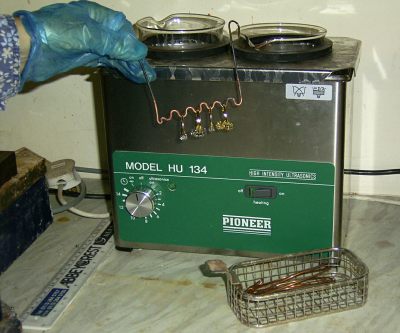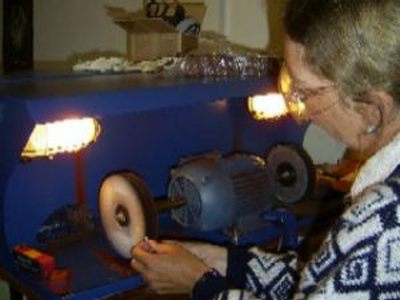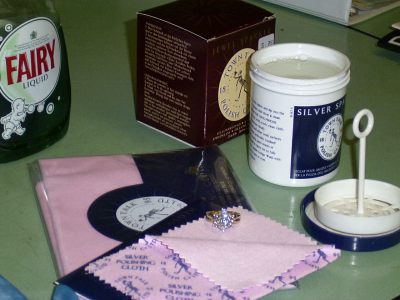
Home cleaning kit: washing up liquid, a polishing cloth, and Silver Dip

Cleaning and Polishing Jewellery
This is actually fun! It's great to take a dirty, dull piece of jewellery and make it shine like new.
The stages
What you need to clean and polish jewellery
Polishing for that perfect shine
How our shop restores jewellery
Bad cleaning can ruin jewellery.

If your jewellery is valuable take it to a jeweller's
shop. If you have any doubts, stop right now!
Check our list of stones, do not use cleaning processes which
could damage them. We don't charge for the advice
here. We can't pay compensation if something goes
wrong.
Examine the jewellery
If you can see any damage, cracks in the gems or
damage to the mount - don't clean it. You might make
things worse. Seek expert advice from a jeweller.
Make certain stones are secure before cleaning - a lost gem will
be expensive to replace.
What you need
- A small brush, for cleaning inside rings and removing dirt. We normally use old toothbrushes, they're cheap and the splayed out bristles can be worked into crevices.
- Washing up liquid, to remove grease and general dirt. Don't use soap, as it is made from vegetable oil. This sticks to diamonds, and is hard to remove.
- Silver Dip. Various brands are available, and they all seem about the same in quality. You simply lower the silver into the dip (after reading all the warnings) and tarnish is removed. Buy it from Jewellers or Hardware shops. Warning: do not use silver dip to clean matt or satin finish silver.
- Silver Polishing Cloth. Polishes silver and gold, and leaves a protective film on silver which delays tarnishing. Warning: do not attempt to polish matt or satin finish, you will spoil it.
- A pair of gloves, to protect your hands from the chemicals. Throwaway polythene gloves are ideal.
- A washing up bowl. Do the work over that, and a gem does fall off, there's a good chance you'll find it.
Don't use Power Tools.
They are too powerful. They can damage jewellery, or
worse, injure the user.
Our staff do use them, but they have extensive training.
Initial Cleaning
We see a lot of jewellery. Quite often it doesn't
look good. There's so much dirt on it, it makes the stones look dull, and even
the metal loses its lustre.
Check the gems against our list.
Can they stand soaking in
water, and how hot? If you can soak the piece, this will
soften the dirt, making it easier to remove. If there are
no gems, then you can use hot water to soak the
jewellery.
Soak the jewellery
If any gems must not be soaked,
or charms have a paper insert,
go straight to the scrubbing stage. Otherwise loosen the dirt by
soaking the jewellery for 15 minutes. Use very hot water, by this
we mean water which has been boiled then allowed to stand for
about 10 minutes. Don't use boiling water, as it could
aggravate unseen flaws already present in your jewellery.
If the piece includes heat sensitive gems then soak the piece in
the hottest water which won't damage the stones..
Scrub it clean
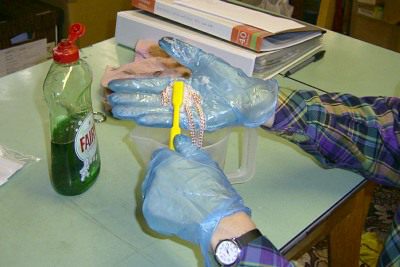
Take the brush, some washing up liquid, and a little water.
Work the brush and some detergent into all the crevices, taking
special care to clean behind the stones (it's amazing how
much dirt accumulates there). Then rinse off, and dry on a tea
towel.
Chains and charm bracelets (assuming none of the charms will be
damaged by water): let them form a heap in the palm of one
hand, then work the brush with some washing up liquid and a
little water into them as thoroughly as possible. Keep on until
the water comes off clean - it will eventually! If the chain
feels stiff, and won't fold into the palm of your hand,
don't force it as that could damage the chain. place one
piece at a time across your hand, and concentrate on that
section. Finally rinse carefully, and dry.
Polishing the Jewellery
Gold on silver and gold vermeil should be treated like gold, until the plating
wears off. Other plated items and costume jewellery can be
damaged by polishing, so leave them alone.
Only polish items which should have a shiny surface. If the piece
has a matt or satin finish; do not polish, but you can remove
discolouration with a soft eraser. Scratches cannot be
treated at home. If you want the finish restored, take it
to a jeweller.
Platinum
This metal is too hard to polish at home. However this hardness means it will last for years before losing its shine. When it needs re-polishing, take it to a jeweller.
Gold
Yellow or red gold won't tarnish under normal
conditions. However certain chemicals - some
used in medicines, others in products like bleach - will cause
discolouration. You can't deal with this problem at
home, your jeweller can help.
White gold may turn yellow after some time; seek help from your
jeweller.
In normal wear gold gets scratched. Rub steadily with
a Silver (or Jewellery) Polishing Cloth, and its appearance will
be somewhat improved. However you will not be able to achieve the
brilliant polish of a new item. If you want the item
restored to that condition, take it to your jeweller.
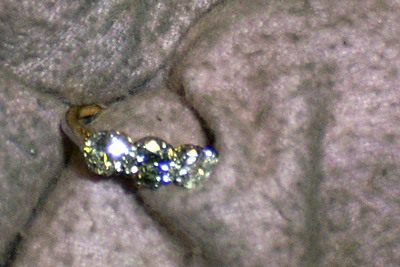
These polishing cloths really work, we use them in our
shop.
Silver
Silver does tarnish with time, so first we must
remove this tarnish. A few pieces are deliberately
'Antiqued' by blackening some parts; clearly removing
this darkening would ruin the effect, so these pieces should
simply be rubbed with a Silver Polishing Cloth to restore the
highlights
Silver dip is the easiest way to remove tarnish. If possible
leave the item to soak for a few minutes. If the
stones shouldn't be immersed in Silver Dip it's best not to clean it with Silver Dip.
If the piece is
too large to fit in the jar, rub the Dip on to the piece
using your brush, it takes longer but the results are just
as good. When the tarnish has been removed, carefully rinse off
all the Silver Dip. As mentioned before, do not use this
product if the silver has a matt finish.
Finally rub the piece with a Silver Polishing Cloth, and you will
restore its sheen. As with gold, you'll never get it to look like new.
If you so desire, your
jeweller can renew the item; however many consider the patina
which develops on hand-polished silver to be very pleasing.
It's normally unwise to get antique silver polished.

